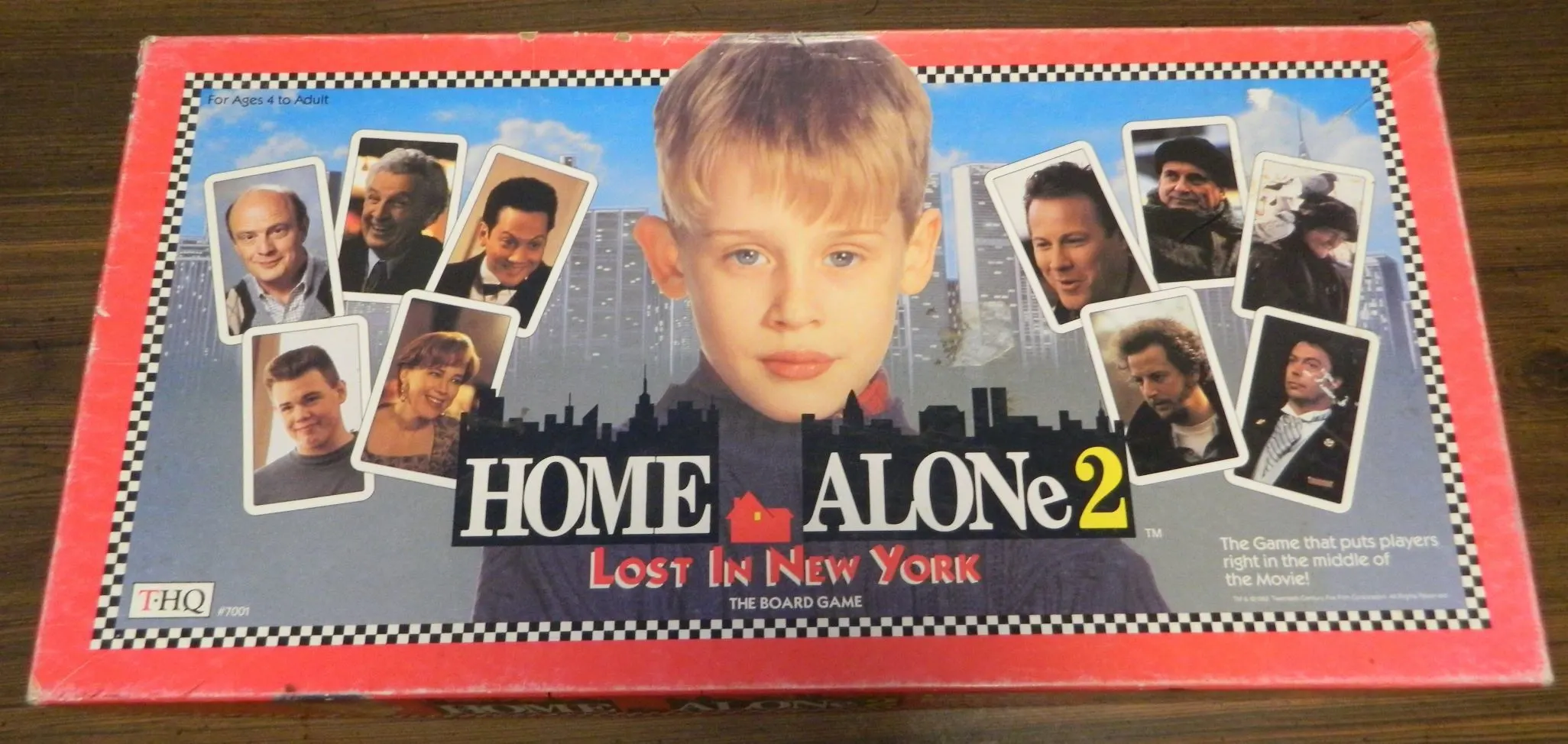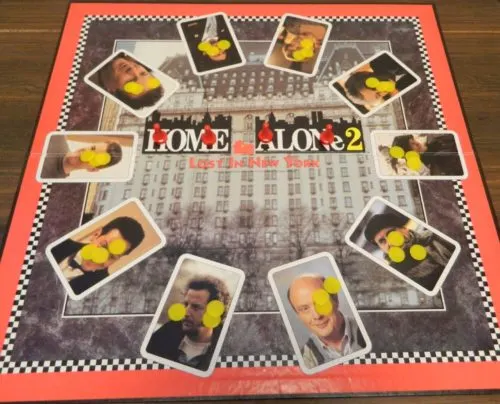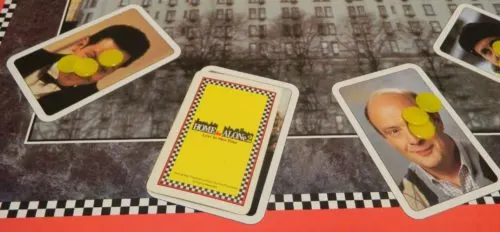Growing up in the 1990s I was a big fan of the Home Alone franchise. The first two movies in the series remain to this day as some of my favorite Christmas movies. The Home Alone franchise was huge in the early to mid 1990s. Because of this the franchise branched off into a lot of merchandise some of which included a number of board games. In fact around the release of Home Alone 2 there were three different board games released. Today I am looking at one of those three games Home Alone 2: Lost in New York. Despite being a big fan of the movie that it was based on, I can’t say that I had high expectations for the game as it looked like your typical cash grab. The Home Alone 2: Lost in New York Board Game is basically what you would expect from a cash grab board game; a slapped on theme pasted on top of a pretty flawed game in its own right.
How to Play Home Alone 2: Lost in New York Board Game
Setup
- Each player is given 15 chips.
- The gameboard is put in the middle of the table.
- Three chips are placed on each character space on the gameboard.
- Place a number of pawns in the middle of the gameboard equal to the number of players minus one.
- The remaining pawns and chips are returned to the box.
- Shuffle all of the cards together.
- Select a player to be the first dealer.
Playing the Game
Each round begins with the current dealer shuffling the cards and dealing four cards face down to each player. The dealer will then place the rest of the deck face down in front of themselves.
The current dealer will begin the round by drawing the top card from the deck and adding it to their hand. They will now have five cards in their hand. The objective is to get three cards in your hand that feature the same character and one Kevin card. The dealer will chose one of the cards from their hand and passes it face down to the player on their left.

The card on the right is the card that this player just drew while the other cards were already in their hand. As this player already had a Marv card in their hand they will likely want to keep the card they just drew. They should pass either the Peter or Kate card to the next player.
The dealer will then draw the next card from the draw deck. At this point the rest of the players will also be playing. Each player will take the top card that was passed to them from the previous player and adds it to their hand. They will then pass one of their cards to the player on their left. Players do not take turns as everyone plays at the same time.
Once a player acquires three character cards of the same type as well as a Kevin card, they will say “Yes” and will take one of the pawns from the center of the gameboard. They are considered the winner of the round. The rest of the players will then race to grab the other pawns. Each player that grabs a pawn will be safe in the round. The player who didn’t get a pawn will lose the round.

This player has three Marv and one Kevin cards in their hand. They can now grab one of the pawns and yell out “Yes” in order to trigger the end of the round.
After scoring (see the Scoring section below) another round is played. All of the cards not placed face down on the gameboard will be shuffled for the next round. The role of dealer then passes to the next player to the left. The next round will then start.
Scoring
The player who collected three cards of the same type as well as a Kevin card will get to take all of the chips from the space that matches the character card that they collected. The player will then take one of the matching cards from their hand and will place it face down on the corresponding space covering it. Players can no longer collect this character during the game. The other two matching character cards will be returned to the deck.
If the player who claimed to have three matching cards and a Kevin card doesn’t actually have those cards, they will be declared the loser for the round. They will have to pay three chips to each player.
The player that didn’t get a pawn will then have to pay out some of their chips (as long as the person who ended the round had the appropriate cards). If the player doesn’t have four cards in their hand, they will draw the top card from their pile and add it to their hand before they pay out chips. If they have more than four cards in their hand, they will have to pay for all of the cards in their hand. The player will pay two chips to the player who won the round for each Kevin card that they have left in their hand.
The player will also have to place two chips on each space corresponding to the other cards in their hand. If one of the characters have already been covered up, you can place the two chips on any other open space on the gameboard.

This is the hand of the player that was unable to grab a pawn. As they had a Kevin card in their hand they will pay two chips to the winner of the round. They will also place two chips on the Peter space and four chips on the Harry space.
If the player who lost the round doesn’t have enough chips to pay all that they owe, they won’t have to pay off the rest of their debts. If there are remaining chips set aside inside the box, the player can borrow them but they will have to pay them back at the end of the game.
End of Game
When there are only three uncovered characters left on the board, the game enters the final special rounds.
When there are only three characters left, each player will only be dealt three cards. For this round each player will try to get two character cards of the same type as well as a Kevin card.
For the next round players will only be dealt two cards. Each player will try to collect one unclaimed character card and a Kevin card.
For the final round each player is only dealt one card. To win this round a player has to collect one other matching character card. (This is exactly how the rules are written as I wasn’t exactly sure what the instructions meant.)
After all of the characters have been covered up (10 rounds), the game ends. The player with the most chips wins the game.
My Thoughts on Home Alone 2: Lost in New York Board Game
I have to begin by talking about the Home Alone 2: Lost in New York theme. It is rare to find a board game that utilizes a theme almost as poorly as this game does. The gameplay might not be contradictory to the theme, but it also shares absolutely nothing in common with it. Honestly without the artwork and the name itself you couldn’t tell if this game was based on the movie or any other theme. Really the only thing that connects this game to its theme is the artwork. The game takes various stills from the movie and plasters them on the gameboard and the cards. That is where the comparison to the movie ends.
The components as a whole are nothing special. The cards aren’t horrible as they feature images of the main characters from the movie. The card stock is pretty much what you would expect from a 1990s board game. The cards are susceptible to creases though mostly because of how the game is played. Players will likely be passing the cards pretty quickly which means that they likely will get creased at some point. The used copy of the game that I found had creases on most of the cards. In addition to the cards you get chips and pawns that don’t really differ from any other game. The final component is the gameboard. The gameboard is typical. The biggest problem that I had with it is that it just feels unnecessary. Outside of having a place to put chips and cards that have already been claimed, it serves no purpose in the game. Instead it just wastes a bunch of space on the table while also making the game’s box much larger than it needed to be.
So the Home Alone 2: Lost in New York Board Game’s gameplay has very little in common with the movie. So what type of game is it? Basically the game owes a lot to the 1972 game Spoons and other similar games. Outside of a few minor changes having to deal with the gameboard and the chips, the two games are basically the same. The premise of the game is to try and quickly decide which cards from your hand to keep and which to pass to the next player. The ultimate objective of the game is to try and get three cards of the same character along with a Kevin card. When this occurs you grab one of the playing pieces. The rest of the players then race to grab the other playing pieces. The player left without a playing piece is stuck giving chips out based on the cards left in their hand.
Those that have seen our review of Giant Spoons should already know that I wasn’t a big fan of the gameplay. Unfortunately the same holds true for the Home Alone 2: Lost in New York Board Game as well. The main problem that I have with the game is that it has a horrible balance between luck and strategy. Basically if you don’t have luck on your side, you have no chance of winning the game. As the goal in the game is to acquire three cards of the same type along with a Kevin card, you have no chance of winning the game if you aren’t dealt/given the right cards. The dealer has a distinct advantage in this area as they can keep drawing cards from the deck looking specifically for a card that they need. If the dealer wants to really take advantage of this they can just immediately discard any card that doesn’t match the other cards already in their hand. The other players have to rely on other players discarding the cards that they need.
It was obvious that a game like this would rely on a lot of luck. I think the game could have overcome it though. The Home Alone 2: Lost in New York Board Game relies on speed and the chaos that it brings. It is kind of fun being able to flip though cards really quickly leaving the next player with a large stack of cards to look through. The faster you go through the cards, the higher the odds of you finding the card that you need. Speed is rewarded in the game and in some ways it succeeds in the same way as many other speed games. Even if you don’t collect the right cards, you can still succeed just by reacting and taking a pawn before the other players. Some of the speed elements can be kind of enjoyable.
The problem is that there is very little else to the game. I could honestly make a pretty good argument that there is no strategy in the game at all. In most cases your best option is to gather two cards of one type as well as a Kevin card. After that point you should just discard any other card that doesn’t match the card type you are collecting. You may occasionally choose to switch your card type if you notice the other players are passing those cards to you. Outside of these rare occurrences though, the gameplay basically relies on looking though cards as quickly as possible. In most cases it doesn’t even feel like you are actually playing a game.
This leads the Home Alone 2: Lost in New York Board Game to become a pretty boring experience. Draw a card quickly and discard it if you can’t use it. That is basically what the game boils down to. The game’s chaos may overshadow some of the game’s monotony, but it is still there. It never really feels like you are actually playing a game. Instead it kind of feels like you a performing an exercise about passing cards around the table.
So I mentioned earlier that there were a couple small differences between the Home Alone 2: Lost in New York Board Game and Spoons. These mostly come down to the chips. Most of these type of games utilize a three times and you’re out mechanic. After the third time that you are left without a pawn, you are eliminated from the game. The Home Alone 2: Lost in New York Board Game utilizes chips though. The player to collect the necessary cards gets to take the chips corresponding to the character they collected. Meanwhile the last player has to pay chips to the winner as well as adding to the pot for the cards remaining in their hand.
I honestly had some mixed feelings about this mechanic. On the positive side I do like that it allows all of the players to remain in the game until the very end. There is no player elimination which is always a positive. This mechanic also rewards the winner of a round instead of just punishing the player who was last. The problem with the chips though is that they add their own issue to the game. Basically winning early rounds in the game doesn’t really matter all that much. You may earn a few chips, but the later rounds are much more important. This is because as the game continues each space will get more and more chips placed on it. By the end of the game spaces will likely have three or more times as many chips on them than at the beginning of the game. This makes the early rounds kind of pointless as the outcome mostly only relies on who wins the last couple of rounds.
This isn’t helped by the fact that the rules for the last couple of rounds aren’t particularly clear and feel broken. Basically as you get close to the end of the game you will be dealt less cards and thus need to find less matching cards. This makes the advantage of being the dealer even greater as it will be much easier to draw the cards that you need. In particular based on how the rules are written the dealer is basically guaranteed to win the final round unless one of the other players is dealt the card that they need.
Should You Buy Home Alone 2: Lost in New York Board Game?
Heading into the Home Alone 2: Lost in New York Board Game I can’t say that I had high expectations. The game ended up being exactly what I expected it to be: a rushed money grab. The game really has very little in common with the movie. Outside of the artwork on the components, you wouldn’t even be able to tell that it is a Home Alone game. The components are pretty average for the most part as well. Basically what is left is a re-implementation of the gameplay from Spoons. You want to get a matching set of cards in your hand and grab a pawn before the other players. The speed element of the game can be somewhat fun at times as it can get pretty chaotic. The problem is that the game relies heavily on luck and there is very little strategy. You basically just pick a type of card and discard any card that doesn’t match it. On top of this the game adds a chip mechanic which makes the early rounds kind of pointless.
I have a hard time recommending the Home Alone 2: Lost in New York Board Game. The gameplay is for the most part Spoons and that can be played with a standard deck of playing cards and some objects that players can grab. Unless you are a huge fan of Spoons or really like speed games, I don’t see the game offering enough to make it worth picking up. Otherwise the only other people that I might recommend the game to are fans of the movie as more of a collectible than an actual board game.
Buy the Home Alone 2: Lost in New York Board Game online: Amazon, eBay



